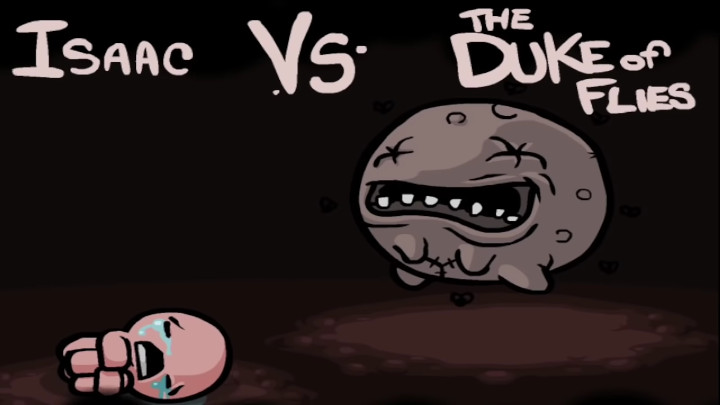
Hello, and welcome to my new series: Lucas Tries Roguelites. I’ll be playing some of the most popular or most important roguelike/roguelite games and highlighting what I like or dislike about them. I’m not sure what I’m hoping to accomplish with this series, other than to explore a genre that I find myself increasingly obsessed with. Like many others, I was swept away by Hades (which I will write about as well), and I found myself wanting to explore the genre further.
But when I start talking about roguelites and roguelikes, The Binding of Isaac is one of the first that usually gets recommended to me, so that seemed like a good place to begin this series.
This was a game a lot of my friends were playing and talking about when I was in high school, so it’s actually sort of weird that I haven’t played it until recently. Even though I was quite a fan of Flash games (during their heyday), I had never played the Flash version of The Binding of Isaac. I have, however, been playing Afterbirth+, the most recent version that’s on the Switch.
And I love it!

The Binding of Isaac is technically a roguelite, as there are elements that carry over from run to run, though those elements are usually subtle. You might unlock an item in one run that you won’t ever actually see until ten runs later, because of the way items are distributed randomly.
The map is generated randomly as well, so each room has a new surprise. In a run, you’ll likely see several of the same enemies, but in so, so, so many different scenarios, depending on the room you find them in.
While I feel I’ve encountered several enemy types over and over again, there weren’t many times where I felt like I’d been in the exact room layout more than once. I’m not always the most observant person, but considering this is the “ultimate” version of a game that’s existed for over a decade, I wouldn’t doubt that I actually haven’t seen the same exact room layout twice. The one major exception to this might be the boss fights, but even the same boss will usually be presented with some variation. Sometimes there are more barriers, or more enemies; sometimes the bosses have different abilities. Even then, you certainly aren’t guaranteed to fight the same bosses every run.

Aside from that, you may not even be in the same chapters/floors on different runs. Normally, you start in the Basement, though in later runs you might start in the Cellar instead (or even the Burning Basement, if you’re playing the Afterbirth version of the game). There is an alternative floor for most of the levels in the game, adding another layer of variety. After you beat Mom the first time, there will be more game to play, with more floors and more enemies.
And on top of that, there’s the classic roguelike/roguelite element of “builds.” Isaac doesn’t offer as much freedom with builds because you select a prebuilt character rather than building your own, but each of the characters on offer feels unique. The agency you have in your build happens organically throughout the game, as you can decide if you’d like to take power-ups or not — though most of the time, you probably don’t know what you’re taking until you have it. But that’s part of the learning process of the game, as well as the worldbuilding.
In fact, the worldbuilding is what really sets this game apart from its peers, and it’s one of the reasons this is such a monumental game in its genre. The basic story is simple, with Isaac running away through the basement to escape his homicidal mom, but the execution is perfect, with the gameplay reinforcing this concept ever step along the way.

The game is constantly giving you bad hands — it won’t hold back on sending you into a room crowded with enemies, or it might bring you to a floor full of locked doors and no keys. That’s by design, and even the randomly generated layouts are in service of this. Isaac is supposed to be lost, so offering a new layout with every run means the player can never feel like they’ve learned their way around.
And there’s so much this game does to antagonize you throughout. Enemies will move in ways to keep you on edge. Maybe they’ll move at a constant speed until they’re close to you, and then they’ll speed up, or maybe they’ll move in a way that surprises you (I’m looking at you, spiders). There are also a lot of projectiles sent your way with few visual cues to warn you (I’m looking at you, bonies).
Even the power-ups can be antagonistic. Many of the power-ups will alter your appearance, usually making you look a bit more messed-up in some way. While most power-ups are good, there are several that make your run more difficult (I’m looking at you, Cursed Eye), and pills lying around that might help you, but are probably more likely to harm you or at least make your run harder for a bit.
On paper, it might sound like the game is too frustrating to play, but it never quite feels that way. There are surely moments where I feel frustrated with the game, but it’s never enough that I give up or resent it. Rather, it’s one of those games where the difficulty makes it more enticing to beat. And when you do get a good build, it feels so great to turn the tables on the enemies and destroy everything in seconds (I’m looking at you, Tech X).
All of the parts of The Binding of Isaac come together to send a message. This game seems to be both about the positives and negatives that come with an obsession with religion, as well as some of the harms of abusive or neglectful parenting in general. The story is a play on the biblical story of Isaac, roughly, which is a wild starting point for a video game. I think the game is largely critical of religion, showing how it can be a harmful tool to instill fear, and points out that the Judeo-Christianity canon has some really dark stories in it. But there is also some exploration of magic in fun and celebratory ways, such as using tarot cards as power ups.
And the idea of a harmful parent is everywhere as well. With all of the “loose pills” everywhere, the items lying around that distort Isaac’s body, and, of course, the central goal of escaping a homicidal parent. The game does a great job of “showing” this rather than “telling.” It’s not overt that these pills are lying around everywhere due to neglectful parenting, but we’re left to interpret it that way.

Playing it now, all these years later and after so many updates, I can see why this game has become such a staple of the roguelite genre. It has staying power, and it’s been updated as recently as December of last year. It’s a fun experience that stays fresh and always finds new ways to stay interesting, while having enough familiarity for the player to get better, which is what makes a good roguelite. It also has an intriguing world that’s both darkly humorous and actually scary at times.
The Binding of Isaac is really, really good. I just hope a decade-late “review” isn’t too dated for y’all.